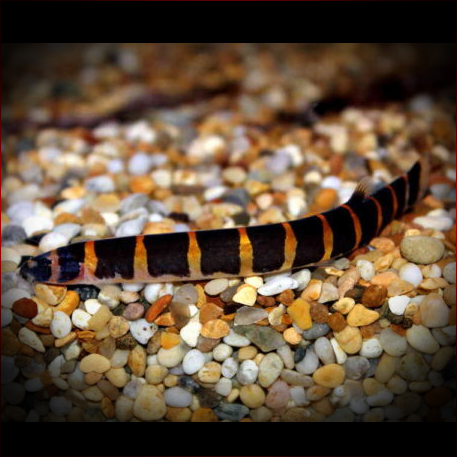More info
Datasheet
| Minimum Tank Size | 60 litres / 15.85 US gallons |
| Maximum Size | 10.0cm / 3.94inches |
| Temperature | 21°C / 69.80°F - 26°C / 78.80°F |
| Hardness | 0.00dgH / 0ppm - 8.01dgH / 143ppm |
| pH | 3.5-7.0 |
Behaviour
Pangio Myersi loaches are known to be peaceful towards each other and other tankmates, with no reports of aggression, though they may prey on eggs and fry. In their natural habitat, they are often found in large groups and tend to huddle together in caves or crevices in aquariums. It is recommended to keep a group of at least 5-6 specimens to ensure their well-being. Optimal tankmates include small, peaceful species such as Boraras, Sundadanio, and smaller Rasbora. It's advised to avoid aggressive or territorial tankmates to maintain harmony in the aquarium environment.
Feeding and Diet
Giant Kuhli Loaches are micropredators that sift through the substrate for food, extracting insect larvae, small crustaceans, and organic detritus. In captivity, they accept sinking dried foods but should also be offered live and frozen options such as Daphnia, Artemia, bloodworms, and micro worms. Providing a varied diet is essential to meet their nutritional needs and ensure their health and vitality.
Reproduction & Dimorphism
Information on the reproduction of Pangio Myersi loaches is currently unrecorded. However, adult females are typically larger and heavier-bodied compared to males. Mature males exhibit a thickened and branched first pectoral-fin ray, which is a distinguishing feature in identifying gender differences among this species.
Habitat and Distribution
Native to the lower Mekong basin in Laos, Cambodia, Vietnam, and Thailand, Pangio Myersi loaches are commonly found in shallow, slow-moving sections of forest streams, swamps, oxbows, and backwaters. They thrive in habitats with minimal dissolved minerals, low pH levels, and soft, shaded waters. Typically, these environments feature substrates of peat, mud, or sand, often littered with leaf debris where the loaches can be found in abundance. Their natural habitat requires careful replication in the aquarium setup to ensure their well-being.
Aquarium Setup
For the optimal aquarium setup for Pangio Myersi loaches, a soft, sandy substrate is recommended to mimic their natural digging behavior. Utilizing driftwood, roots, and branches to create shady areas, along with dried leaf litter for cover, enhances the aquarium environment. Dim lighting and the inclusion of aquatic plants such as Microsorum, Taxiphyllum, and Cryptocoryne are beneficial. Gentle filtration with minimal surface agitation is preferred, and precautions should be taken to prevent small specimens from entering filter intakes and to secure the tank to prevent jumping behaviors. Water conditions should be maintained within a pH range of 3.5-7.0, hardness of 0-143ppm, and temperature between 21-26°C.

